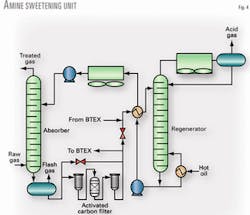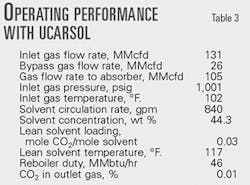Louisiana gas plant hikes production with quick solvent changeout
BP Exploration Inc. increased production and improved performance in its Judge Digby (La.) gas plant by replacing the diethanolamine (DEA) solvent with a specialty methyl-diethanolamine solvent in a process that took less than 24 hr.
Dow Chemical Co.'s Ucarsol AP-814 solvent lowered corrosion rates, solvent consumption, and filtration costs, all without major equipment modifications.
Other solvent formulations now available give engineers the ability to increase overall sales-gas production capacity without making a large capital investment in new or modified equipment.
The Dow specialty amine met BP's needs at its Judge Digby gas-treating plant because the solvent has a high CO2 carrying capacity.
null
When demand for natural gas is high, processing plant operators must maximize production rates or lose revenue. Shutdowns to increase capacity must be factored into the economics.
Solvent changeouts take less than 24 hr in many cases with the techniques used at the Judge Digby gas plant.
Judge Digby plant
BP's Judge Digby gas-treating plant is in the Pointe Coupee Parish in southern Louisiana. The amine unit treats a raw natural gas stream containing about 8 mole % CO2 and 40 ppm H2S (Table 1) and produces a sales gas with less than 3% CO2 and 8 ppm H2S.
The plant includes Train 1, a 150-MMcfd amine unit followed by a tetra-ethylene glycol (TEG) dehydration unit, and Train 2, a 100-MMcfd TEG dehydration unit only.
null
In 2000, well production exceeded the plant's operating capacity due to an amine unit bottleneck. The plant was originally designed to produce 150 MMcfd of treated gas; before 2000 its capacity had declined to less than 135 MMcfd.
Train 1 was designed to remove about 95% of the acid gas from 120 MMcfd of raw gas in the sweetening unit. A 30-MMcfd stream of raw gas bypasses the amine unit and combines with amine plant treated gas to yield 150 MMcfd that meets the desired CO2 and H2S specification.
Bypass gas is treated with a nonregenerable H2S-scavenging chemical before being blended with the sales gas.
BP's sweetening unit is a conventional amine treater designed to use 30% DEA. The plant came online around 1970.
A 1999 engineering study indicated the maximum throughput for Train 1 was 135-140 MMcfd. At production rates greater than 140 MMcfd, the unit was unstable and required 24-hr manned operation.
The DEA system exhibited several problems. The DEA solution had degraded and the reboilers were severely fouled. Probes indicated high corrosion levels.
The regenerator still was hydraulically limited and unable to fully strip the rich DEA solution. Lean solution loadings of 0.06-0.07 moles of CO2/mole of DEA were typical. Fully stripped DEA should contain less than 0.02 moles of CO2/mole of DEA. High solution lean loadings and solution degradation products can lead to corrosion and reboiler fouling problems.
High CO2 loading in the DEA from the regenerator also prevented the absorber from removing all the CO2 from the raw gas; therefore, there was too much CO2 in the gas leaving the DEA unit.
Instead of treating and bypassing 122.5 MMcfd and 30 MMcfd, respectively, the plant could only treat and bypass 122.5 MMcfd and 13.5 MMcfd to produce a combined sales gas volume of only 135 MMcfd that contained less than 3% CO2.
null
BP considered several options to regain lost capacity that required weeks of downtime for equipment modifications.
The contactor was hydraulically limited to a feed rate of about 120 MMcfd, which also limited BP's options. Flow rates greater than the contactor's hydraulic limit resulted in large amine losses, increased corrosion, and operating instabilities.
To maximize production, BP wanted to maximize the bypass gas flow rate and the amount of CO2 removed in the absorber.
BP also wanted to reduce the number of plant upsets at high flow rates. The plant is unmanned 16 hr/day; upsets during unmanned periods increase the number and cost of off-shift operator callouts. Each unplanned shutdown had adverse effects on producing wells.
BP decided to replace the existing DEA solvent with Dow's AP-814 solvent. With a new solvent, the plant would require less regeneration duty and would absorb more CO2.
The solvent changeout would require less than 24 hr without an extensive system cleanout. In addition, the solvent switch required no mechanical equipment modifications.
Preparing for the conversion
null
null
BP performed a gamma scan of the absorber and regenerator before the solvent switch. An engineering analysis of the reboiler showed that it was severely fouled.
Two cleaning crews manned the shutdown to ensure timely cleaning of the reboiler tubes. The cleaning process was the time-limiting step; BP spent 32 hr cleaning out the severely fouled tubes before halting the process.
BP removed the DEA from its storage tank and shipped it to another facility. The storage tank was cleaned and filled with an initial charge of 45 wt % AP-814. Two anti-foams were brought to the site:
- A start-up antifoam that prevents foaming created by solids.
- An antifoam for normal operations.
BP's plant did not allow continuous antifoam addition to the stripper; therefore an antifoam charge pump was added to this section of the plant.
BP completed a management-of-change document and a process-hazard analysis to consider all the changes needed to accommodate a solvent switch, including special issues such as metallurgy, equipment configuration, pump design, gasket materials, and other items. The reviews indicated that no additional modifications were needed.
Dow personnel conducted training for the unit operators and BP engineers. Training focused on new laboratory test methods, operating techniques, and operating parameters with the new AP-814 solvent.
Operations then designated a time window for the reboiler cleaning and solvent change-out.
The turnaround
In October 2000, BP removed the DEA from the sweetening unit and drained all the low points as much as possible. The amine unit was flushed with water and drained. The activated carbon filter was emptied and filled with a fresh charge.
A gas chromatographic analysis of the new solution after start-up indicated that only trace amounts of DEA remained in the system.
Originally, BP planned to remove the reboilers from the system—using isolation valves on the inlet and outlet—and clean them during the solvent switch. The valves unfortunately leaked and the reboilers had to be cleaned before fresh solvent was added to the unit.
The solvent swap would have taken 4 hr if the block valves had not leaked. The material in the reboilers was likely iron carbonate, which was difficult to remove. After hydroblasting the reboiler tubes for more than 32 hr, BP decided to abandon the effort and bring the unit online. About 20-30% of the tubes remained plugged with iron carbonate.
The unit started up smoothly with the new solvent. In a preliminary test run, the plant produced the expected additional 20 MMcfd of gas, even with the fouled reboiler tubes.
Plant operations
The plant had operated for 1.5 months when well production was lost. Table 3 shows performance data collected during that time.
Because the new solvent removed more , BP could mix sweetened gas with more untreated gas. The new solvent allowed more operating flexibility, which helped compensate for less-than-optimum reboiler performance.
After BP restarted the wells in March 2001, the plant could not run at high rates because the reboiler tube condition had worsened. BP eventually replaced the reboiler bundles.
Table 4 shows plant performance with APCO2-814 and the historical maximum performance with DEA.
After bundle replacement, the plant had no problem meeting design capacity. A $3.00/Mcf gas sales price translates to an incremental increase in sales revenues of about $34 million/year.
The amine sweetener includes a contactor, regenerator, and BTEX stripper (Fig. 3).
Operating costs were essentially the same with AP-814 despite the capacity increase. The amine unit could theoretically process up to 168 MMcfd if other bottlenecks were removed.
BP operators observed these performance improvements after the change-out:
- Lab tests show no indications of solvent degradation.
- Solvent losses are low. The sweetening unit runs for months with no significant change in solvent concentration.
- During the change-out, BP replaced the 10-μm particulate filters with 5-μm filters. The new filters are changed out half as often; operations staff is considering 2.5-μm filters.
*Corrosion is low. Corrosion monitoring probes that indicated high levels of corrosion with DEA are now reading low levels. Low iron levels in the solvent and good performance from the 5-μm filters confirm this finding.
The sweetening unit performs well during upstream upsets and well outages.
BP conducted a test run using the new solvent as the H2S scavenger for the bypass stream. The tests were successful and BP is considering a project to replace the existing acid-gas scavenger with an AP-814 slipstream, which can be sent back to the rich line in the sweetening unit. This plan will reduce operating costs.
BTEX emissions
Many natural gas streams contain some BTEX; this includes gas processed at the Judge Digby site. Whereas BTEX compounds have a high fuel value, they are regulated for human contact and air emissions. Many natural gas processing facilities now capture BTEX from the vent streams.
BTEX is more soluble in amine solvents than other hydrocarbons. BP has a BTEX-removal unit that strips BTEX from the rich amine. The unit is on the rich-amine line between the rich-amine filters and lean-rich heat exchanger.
Fuel gas is the stripping agent. This gas, along with any acid gas stripped out with the BTEX, is recovered and routed to the plant's fuel-gas system.
BP has evaluated BTEX unit capacity with the AP-814 solvent at higher rates to determine optimum operation. The change from DEA did not significantly alter the load on the BTEX removal system.
Acknowledgments
The authors thank Terril David, BP operations team leader, Don Ferguson, BP construction project lead, Judge Digby's operation and construction crews, and Jim Ronnander and Rich Ackman, both of Dow Chemical Co.
Based on a presentation to the 54th Annual Laurance Reid Gas Conditioning Conference, Feb. 22-25, 2003, Norman, Okla.
The authors
Sally Jackson is a facilities engineer for BP PLC, Houston. She joined BP in 2000 and works in the company's South Louisiana asset. Jackson previously worked as a gas processing engineer for Amoco Corp.'s natural gas business unit, and has also worked for Olin Corp., Vulcan Chemicals, Mobil Corp., and Jacobs Engineering Group Inc. She holds BS in chemical engineering from the University of Southwestern Louisiana (now the University of Louisiana at Lafayette).
Bob Hlozek is a technical service manager for Dow Chemical Co. He joined Dow (formerly Union Carbide Corp.) in 1987. Previously, Hlozek held positions with Production Operators Inc. (now part of Schlumberger), InterNorth Inc. (now Enron), Black & Veatch Pritchard Inc., Gulf Interstate Engineering Co., Celanese Chemicals Ltd., and ICI Americas Inc. He holds a BS in chemical engineering from Texas A&M University. Hlozek is a registered professional engineer in Texas and a member of AIChE.










